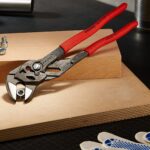Knowing which way is loose on a socket wrench is key to tackling any repair or DIY project with confidence. If you’ve ever struggled to figure out which direction to turn your wrench, you’re not alone. Understanding the right way to loosen bolts or nuts can save you time and prevent damage to your tools and hardware.
Most socket wrenches follow a simple rule, but there are a few tips you should keep in mind to avoid frustration. Whether you’re a beginner or just need a quick refresher, mastering this basic skill will make your work smoother and more efficient. Let’s dive into how to easily identify the loosening direction on your socket wrench.
Understanding Socket Wrenches and Their Directions
Socket wrenches offer a practical way to tighten or loosen fasteners with efficiency. Learning how their directional mechanisms operate helps you work with precision and speed.
What Is a Socket Wrench?
A socket wrench consists of a handle and a removable drive head that fits various socket sizes. The socket grips nuts or bolts securely, allowing you to apply torque without slipping. This tool suits confined spaces better than a standard wrench, thanks to its ratcheting feature, which permits continuous turning without removing the wrench.
How Do Directional Settings Work?
Directional settings on a socket wrench control the ratcheting mechanism. You switch between tightening and loosening by flipping a small lever or dial near the wrench’s head. When set to loosen, the wrench turns fasteners counterclockwise. When set to tighten, it turns them clockwise. Some models label directions with “L” for left/loosen and “R” for right/tighten for quick identification. Understanding this functionality eliminates guesswork and enhances your control during use.
Identifying the Loose Direction on a Socket Wrench
Understanding how to pinpoint the loosening direction on your socket wrench ensures precise control during your projects. Use the following guidelines to confirm the correct setting quickly and confidently.
The Standard “Righty-Tighty, Lefty-Loosey” Rule
Turn your socket wrench counterclockwise to loosen bolts or nuts. Rotate clockwise to tighten them. This rule applies to most fasteners with right-hand threads. Exceptions exist, such as left-hand threaded fasteners found in some machines and bicycles, but they are rare. Sticking to this basic rule speeds up your work and reduces errors.
How to Check the Direction Lever or Switch
Locate the small lever or dial near the wrench’s ratchet head. It switches the wrench between tightening and loosening modes. Position the lever for counterclockwise rotation if loosening is required. Move it to the clockwise setting for tightening. Some wrenches display arrows or letters (“L” for loose, “T” for tight) near the lever for easy reference. Testing the wrench on a loose bolt confirms the correct direction before you start.
Tips for Using a Socket Wrench Effectively
Mastering proper socket wrench use improves your efficiency and prevents hardware damage. Follow these guidelines to maximize your wrench’s performance.
Adjusting the Direction Switch Safely
Always stop turning the wrench before changing the direction switch. Engage the switch firmly to avoid slipping or incomplete engagement. If the switch feels stuck, apply gentle pressure rather than forcing it. Confirm the switch position by testing it on a loose nut or bolt before applying full torque.
Common Mistakes to Avoid
Forcing the wrench when resistance is high risks stripping fasteners or damaging the tool. Avoid using sockets that don’t fit snugly; loose sockets increase the chance of rounding bolts. Neglecting to confirm the lever position causes unnecessary wear and prolongs task time. Refrain from using excessive force when loosening, especially on rusted or painted fasteners, to prevent breaking the bolt.
Conclusion
Knowing which way is loose on a socket wrench makes your projects smoother and saves you from unnecessary frustration. By getting familiar with the direction lever and remembering the basic turning rule, you’ll work faster and protect your tools and hardware. Taking a moment to double-check settings before you start can prevent common mistakes and keep everything running efficiently.
With these simple steps, you’ll handle any fastening job with confidence and ease.
Frequently Asked Questions
How do I know which way to turn a socket wrench to loosen a bolt?
Turn the socket wrench counterclockwise to loosen most bolts, following the “lefty-loosey” part of the common phrase. Check the directional lever on the wrench to confirm the loosening setting.
What does the lever or switch on a socket wrench do?
The lever or switch near the wrench’s ratchet head changes the turning direction, allowing you to switch between tightening (clockwise) and loosening (counterclockwise).
Does the “righty-tighty, lefty-loosey” rule always apply?
It applies to most right-hand threaded fasteners, but not to left-hand threaded bolts which loosen clockwise. Always check your specific fastener if unsure.
What should I do before starting to loosen a bolt with a socket wrench?
Confirm the direction lever is set to loosen and test the wrench on a loose bolt to make sure you’re turning it the right way before applying force.
Can forcing a socket wrench damage the tool or hardware?
Yes, forcing the wrench can strip bolt heads, damage the wrench, or break fasteners. Use proper socket size and avoid forcing against high resistance.
How can I avoid slipping when switching directions on a socket wrench?
Always stop turning before flipping the direction switch, and ensure the lever is fully engaged before resuming to prevent slipping or damage.
Why does my socket wrench have different sized sockets?
Different socket sizes fit various bolt and nut sizes, providing a secure grip to apply torque efficiently without slipping or rounding fasteners.
What common mistakes should I avoid when using a socket wrench?
Avoid forcing the wrench, using the wrong socket size, neglecting to check the direction switch, and applying too much force on rusted or painted fasteners.

